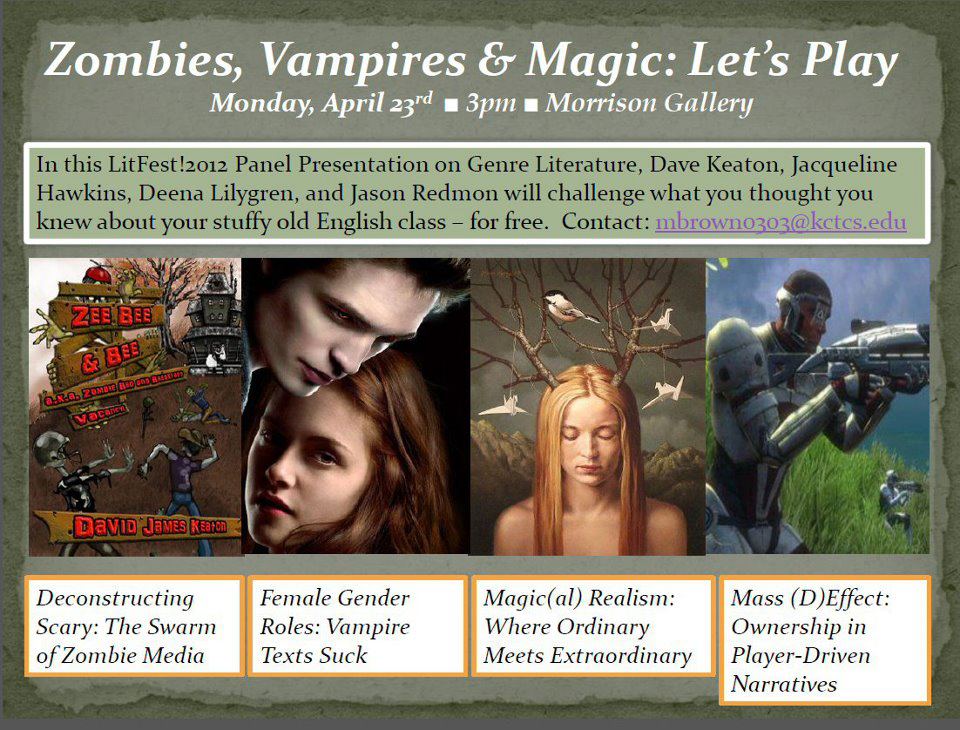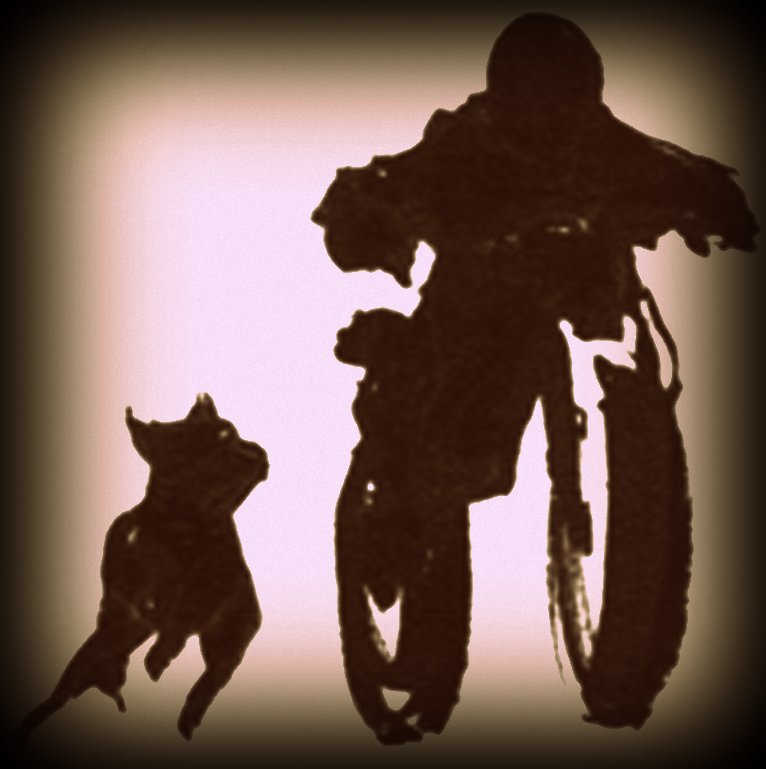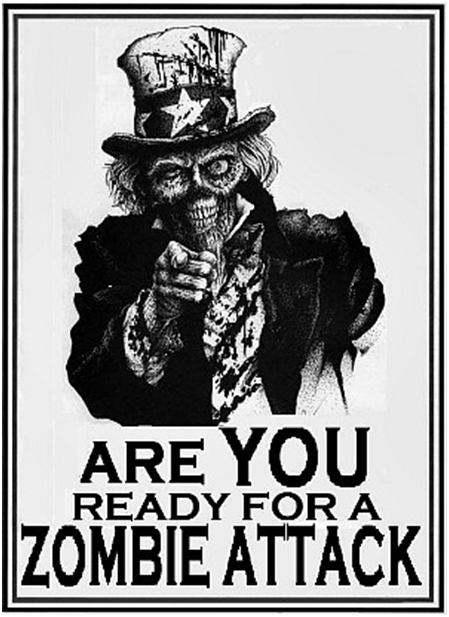So, here’s an online version of a presentation I gave for our Elizabethtown genre-writing panel last month, cobbled together from about ten pages of bullet points and gibberish. No one believes the title is a Harry And The Hendersons reference and not a Woody Allen reference. Including me…

I’ve changed my title three times now, not including today. Doesn’t “surge” sound better than “swarm” though?
Deconstructing Scary: Gun Nuts & The Surge Of Zombie Media
I. The Surge
Lately, zombies have reached a critical mass. In 2013, my class and I tried to list all the zombie stuff that would be hitting theaters and bookstores that year, and here are just a few of new zombie novels and films from that year alone. The next year this number doubled, and there will likely be at least one more zombie screenplay greenlit (“greenlighted”?) by the time I’ve finished this list:
Atom the Amazing Zombie Killer, Dead Season, Dead World, Dead of Night, Dead Juju, Dead Man Talking, A Few Brains More, The Harvard Zombie Massacre, I Walked With A Zombie, Infected, Invasion of Not Quite Dead, The Infected, Night of the Living Dead Origins in 3-D, Portrait of a Zombie, The Riot, The Uglies, Winter of the Dead, The Killing Floor, The Dead, Zombie Apocalypse Redemption, A Little Bit Zombie, Boy Scouts Vs. Zombies, Condition Dead, Dead Condition, Condition Red, Red Man Walking, Infected Dead of the Invasion of the Not Quite Dead, Dead Man Stalking, Dog of the Dead, Dead Dog Riding the Rising Tide of the Dead…
Okay, I may have made a couple of those up, but parodies might be indistinguishable, like a Poe’s Law (of the Dead) situation. And this doesn’t include the glut of zombie video games that have also flooded the market. And the three zombie love songs that were written just now.
Oh, and there’s some sequel-itis of course, Deadlands 3, Zombieland 2, Resident Evil 5, and 28 Months Later, the sequel to 28 Weeks Later, which was the sequel to 28 Days Later, which, along with the Dawn of the Dead remake, George Romero’s long-awaited Land of the Dead, were the introduction of a new sort of running, “rage-fueled” version of the undead.
Also, before we forget, 2012 marked the release of a little film with a deceptively simple title, Cabin In The Woods. And it basically tried to throw a bone to every horror film ever made. But what’s telling is (minor spoiler alert) the characters in the film are betting on a horror-movie-type situation inside this cabin, on which horror movie staples the characters will inadvertently choose to do themselves in with: evil clown, creepy little girl, monster snake, unicorn, merman… (merman? yes, merman) et cetera, and one cautious gambler just picks “zombies” on their giant betting pool board. Indeed, zombies turn out to be that evening’s villains. But they also turn out to be a certain variety of zombie, and the woman who made the bet wants her money when they start popping out of their graves. But another, wiser character sets her straight with this:
“Yes, you picked ‘zombie,’ but this is a Zombie Redneck Torture Family. Entirely different thing. It’s the difference between an elephant and an elephant seal.”
We can hope for these kinds of subtle distinctions between these next hundred or so zombie films, but it’s probably more likely we’ll actually be looking at the difference between an elephant and an elephant. And, to be honest, once the true intentions of the film Cabin In The Woods become clear, it’s obvious that not only was that zombie redneck brood/run-of-the-mill zombie distinction unnecessary, but that the real reason zombies were chosen by the filmmakers is simply because they are an obstacle with the most easily recognizable characteristics, making them as unimportant to the proceedings as if the characters were battling the weather instead.
Another big movie that was looming for awhile (and there’s been a lot of hope pinned on this one) was the much anticipated adaptation of Max Brooks’ sorta People’s History of the Zombie-fied United States: World War Z. Truthfully, what this book’s structure most resembles is that verbal history of the Beastie Boys that Rolling Stone published in the 90s. It looked unfilmmable, and, oops, maybe it was. Because this movie was pushed back for years, and then plagued by re-shoots, leading some to (perhaps unfairly) speculate that zombie oversaturation in (critical) mass media had finally occurred.
Yeah, maybe not though. In zombie literature, it was Max Brooks’ earlier Zombie Survival Guide, a tongue-in-cheek guide to surviving a zombie apocalypse, that was more than a little responsible for the resurgence of the genre. This was because it took these situations further out of the horror arena and more into the closing credits of Romero’s original film, the survivalist’s fantasy.
In this book, you discovered very matter-of-fact instructions on how to survive. For example, avoiding hooded sweatshirts because they’re way too easy for zombies to snag (a very timely warning considering the Treyvon Martin case). It also explained you should wear ear plugs so the constant moaning doesn’t rattle you, as well as other practical advice on choices of bladed or blunt weapons, treatment of the infected and so on. In fact, the recent Zombieland (soon to be its own TV series) cribbed its own variation of these tips, counting them down on screen as the heroes ignored them to their peril. That movie also tapped into what is so intoxicating about the genre (besides killing with impunity, of course) by featuring a scene also found in every respectable zombie film, novel, or comic book (it’s right up there with the scene where some motley crew trashes a grocery store or shopping mall, celebrating a completely new society). I’m talking about when the characters finally arm themselves during a montage, usually a somber, almost reverential stockpiling of wonderful weapons:
II. Survival Nuts
Which leads me to some mixed nuts. There’s a fine tradition of apocalypse scares and battening down the hatches and Y2Ks and Mayan calendar nonsense, giant sun flares, the occasional asteroid or rogue planet. But what most of these more popular scenarios have in common is not a genuine fear of impending doom. As someone who’s seen half of these trends come and go, realizing the most direct results are just empty grocery store shelves and a massive stockpiling of weapons, the connection has little to do with science fiction scenarios.
The latest “scare” (scare in scare quotes, because there’s nothing scary about it) is the zombie apocalypse. And this current incarnation of Armageddon really was the most predictable because even when offered up something obviously supernatural (hell, at least there is a sun that could have a sun flare), at the drop of a camouflaged hat people start hoarding guns and ammo, even hand-crafting blunt instruments in record numbers.
Recently, a student brought to my attention this advertisement video for “zombie” killer bullets:
As you can see, a survival type ducks around cars, shoots hordes of zombies in the face and chest, slides across the hood like the Dukes of Hazzard, looking oh, so serious, but clearly having a blast. Did you get to the end? The disclaimer? They claim “this is only for use on zombies. Zombies is not a cute code word for anything except zombies!”
Uh, right. But “zombie” is a code word. In the inner city, it’s what they call drug addled homeless people, often minorities. The fact that they needed this disclaimer should be alarming. It proves that conversation happened at this manufacturer, just like it happens on the online hunting forums.
So, if we can substitute any reason at all for survival types to stock up on canned beans, bullets, and guns, then there must be a deeper reason, right? Could it be an economic reason? This downturn is no coincidence. Do the previous scares, Y2K, etc., coincidence with high rates of unemployment? Sure do. Or are human beings just wishing they can shoot someone in the head? That, too. (If you don’t already know, this is the most popular way to deal with a “zombie”) Could these rugged, zombie-minded men and women really be afraid of a horde of homeless, rather than anything voodoo-related? It doesn’t seem like too big of a leap that the homeless population would be the first victims in the event of any Orson Wells War of the Worlds-type media scare.
The original Twilight Zone had an episode that’s been often imitated called “The Monsters Are Due On Maple Street.” The film The Trigger Effect was its most obvious descendent, even calling the intersection where the story begins “Maple Street” as an homage (or apology), and there’s Stephen King’s recent Under The Dome, too (that book is arguably a bit redundant of the plot of The Simpsons movie, or vice versa as the author recently presented evidence of a first draft of his book that dated back to the ’70s).
But in this Twilight Zone episode, a cul-de-sac suddenly loses power. And by morning… yep, they’re killing each other. Just like the popular new series Walking Dead demonstrates, the real problems result from the loss of phones, electricity, and technology, not from monsters. Zombies are only the flavoring on any apocalypse.
III. Zombies In Your Classroom
Up in Chicago at AWP this year, there was the usual talk about not restricting students to literary fiction in the workshop. This weaary discussion has been around since my undergrad days, and no one had an easy answer then either. I would agree that genre fiction should be welcomed in the workshop arena, but I would also caution that a few restrictions never hurt anybody. I, myself, used to have trouble coming up with titles for works, much like Fiona Apple and her famous When The Pawn… blah blah blah… zzzzzzzzzz (and her upcoming The Idler Wheel Is Wiser Than The Driver of The Screw And Whipping Cords Will Serve You More Than Ropes Will Ever Do, which is short for her actually), so I told myself they would all be three words. Three words only, then I’m out! And for a while that worked. It turned out I had been hindered by creative freedom, or at least used it as an excuse for inactivity. A little focus did wonders for my own productivity. So, as obnoxious as it usually seems, I began to think that maybe my own solution could be universal? Therefore, I propose we ban literary fiction entirely, which is of course a genre just like anything else. Just kidding. Sort of. Not really. Flee!
Honestly, I would say it depends on the teacher. As a student, if your instructor has no knowledge (or, worse, no respect) of horror, crime, science fiction, or fantasy, he or she is less likely to be familiar with that genre’s strengths and less likely to offer good advice. As a student, you should always use your teachers to the best of their abilities and understand that there will always be a clash between what you’re required to read and what you enjoy. If you restrict the genre in which you write to just one, you will have less to apply to your own writing as classes aren’t usually geared toward any particular genre. Oh, yeah, except literary fiction. Literary fiction becomes the catch-all. But, hopefully, quality will out. A good story, regardless of genre, should be recognizable to anyone with a passing knowledge of what constitutes good literature, student and teacher alike. Fingers crossed.
But good fiction of any kind mobilizes fears, horror fiction even more so. Therefore genre is a perfect opportunity to talk about the cultural imaginary in the classroom. So if you begin to notice an increased interest in guns, zombies, and the end of the world in your town, this will likely find its way into students’ work or into your class discussions in other ways. How can this fantasy to trash grocery stores, strap chainsaws onto your 4×4 (or kill with impunity!) be productively directed towards a critical engagement with a climate that’s producing such desires? Analyzing any zombie story by peeling away the random violence or genre tropes and instead concentrating on the characters’ concerns about their environment, the radical change in power structures, and of course the most dominating theme, the day-to-day survival such as finding food and caring for a family, is a good way to read these texts as a glimpse into the larger cultural imaginary, how we act out the priorities of a larger culture in which we make meaning.
So maybe we aren’t completely constructed by individual desire after all. And maybe our students here in the South (or students writing genre fiction) cannot be dismissed as typical gun collectors when they are collecting cultural anxieties instead.



